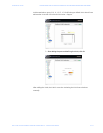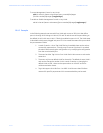
CHAPTER 10: VLAN CONFIGURING TAG VLANS THROUGH THE COMMAND LINE INTERFACE
MULTILINK ML1600 ETHERNET COMMUNICATIONS SWITCH – INSTRUCTION MANUAL 10–13
10.4 Configuring Tag VLANs through the Command Line Interface
10.4.1 Description
When multiple switches are connected on a network, the VLAN information needs to be
propagated on to other switches. In such situations - it is best to use tag based VLANs.
Note
For versions 1.6.1 and below, the use of tag VLANs needed the set-ingress and set-egress
commands to set the flow of incoming and outgoing traffic. As of MultiLink Switch
Software version 1.6.1 - these commands are defunct. For legacy reasons, these
commands will still work with release 1.6.1 (and will print a message on the screen
indicating the commands are deprecated), however, GE recommends very strongly
stopping using these commands and using the set-port command instead.
10.4.2 Commands
The set-port command for setting Tag VLANs has the following parameters. The
default id parameter sets the default VLAN id (termed PVID in previous versions). The
default VLAN id is the VLAN id assigned to the untagged packets received on that port. For
Multilink family of switches, the default VLAN id is 1
set-port port=<number|list|range>
default id=<number>
The
filter parameter enables or disables the VLAN filtering function. When enabled, the
switch will drop the packets coming in through a port if the port is not a member of the
VLAN. For example, if port 1 is a member of VLANs 10, 20 and 30, if a packet with VLAN id
40 arrives at port 1 it will be dropped.
set-port port=<number|list|range>
filter status=<enable|disable>
The
tagging id and status parameters define whether the outgoing packets from a port
will be tagged or untagged. This definition is on a per VLAN basis. For example, the
command
set-port port=1 tagging id=10 status=tagged will instruct the
switch to tag all packets going out of port 1 to belong to VLAN 10.
set-port port=<number|list|range>
tagging id=<number> status=<tagged|untagged>
The
join id parameter adds the specified port(s) to the specified VLAN id. This parameter
works with active or pending VLANs.
set-port port=<number|list|range>
join id=<number>
The
leave id parameter releases a specific port from a VLAN. For example if port 1
belongs to VLAN 10, 20, 30, 40 the command set-port port=1 leave id=40 makes port 1
belong to VLAN 10, 20, 30, dropping VLAN 40.
set-port port=<number|list|range>
leave id=<number>
The
show-port command lists all parameters related to tag VLAN for the list of ports. If
the
port parameter is omitted, it will display all ports.
show-port [port=<port|list|range>]


















